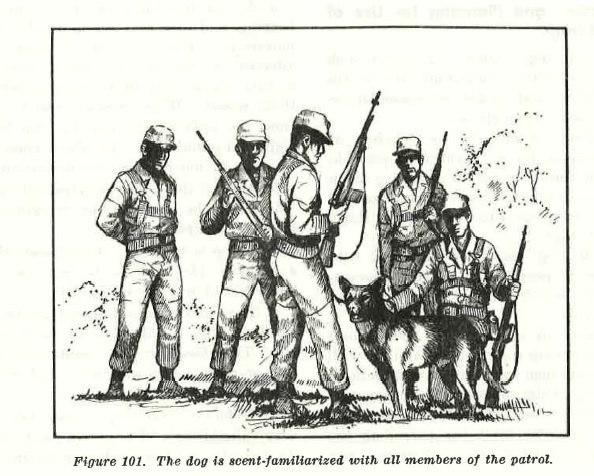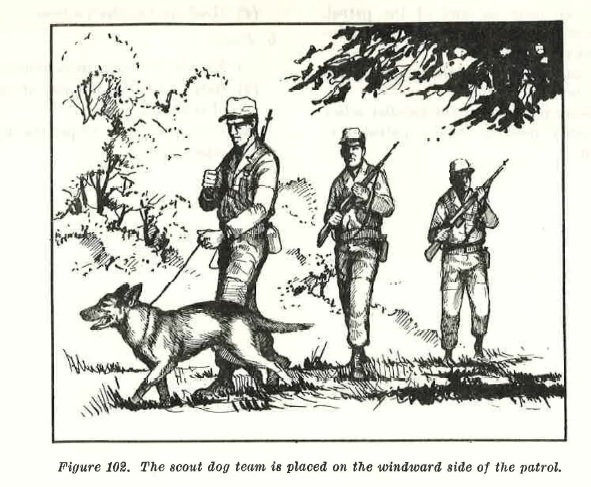Donate
| SECTION I | ---------------------------------- | GENERAL |
| SECTION I | ---------------------------------- | USING SCOUT DOGS IN PATROL. |
219. The Infantry Platoon (Scout Dog).
Scout dogs used in the Army are found in numbered infantry platoons, such as the 26th Infantry Platoon (Scout Dog). Elements of a platoon are attached to units for specific missions or periods. They are employed as scout dog teams, each team consisting of a scout dog and a handler (FM 20-20).
220. Mission.
The mission of a scout dog team is to support the patrol by detecting the enemy and giving silent warning. Teams may also assist on observation posts, outposts, and listening posts.
221. Preparation and Planning for Use of Scout Dogs.
| NUMBER | DESCRIPTION |
| a. | When a scout dog platoon is attached to an infantry unit, the platoon commander advises the commanding officer and makes recommendations for the employment of the platoon. |
| b. | The platoon commander is briefed on planned missions as far in advance as possible. This allows him time to select the scout dog teams which will be most effective for each mission. It also gives the handlers time to prepare themselves and their dogs. |
| c. | When scout dog teams are employed with units that have not previously used them, personnel are carefully oriented on the team's capabilities and limitations. |
| d. | The presence of a scout dog team causes varied reactions among personnel unfamiliar with scout dogs. Some men on1y feel an exaggerated sense of security while others may become agitated and apprehensive. Prevent these extremes by having the handler brief the patrol on the team's purpose, capabilities, limitations, and method of operation. Have the handler let each man touch and stroke the dog briefly to show them they need not fear the dog. |
| e. | A scout dog team is attached to a small unit such as a patrol for a particular mission. When possible, the same team works with the same unit or patrol for different missions. Performance improves as the team becomes familiar with the personnel. |
222. Limitations of Scout Dog Teams.
Alertness must still be maintained when a scout dog team accompanies a patrol. The team can almost always detect the enemy before the patrol, but both handler and dog have limitations.
| NUMBER | DESCRIPTION |
| a. | A scout dog has an acute sense of smell, keen hearing, and eyes that are unusually sensitive to movement. The dog's use of these faculties is affected by weather and terrain conditions such as rain, smoke, fog, dust, heavy underbrush, and thick woods. ·when weather and terrain conditions are unfavorable, the dog can be used for sight and sound alert. Its effectiveness is reduced in areas of much noise and movement. |
| b. | A scout dog must be retrained periodically. The longer he goes without retraining, the less effectively he performs. |
| c. | A dog is subject to the elements the same as a human. He tends to be less alert when extremely cold or when overheated. |
| d. | The handler must concentrate on "reading" his dog. This is difficult to do for extended periods. Therefore, for best results on long patrols, two or more teams are taken and rotated periodically. |
| e. | Despite limitations, a scout dog team is a very valuable aid. The patrol must capitalize on its strengths while considering its limitations. |
SECTION II. USING SCOUT DOGS IN PATROL.
223. Preparation.
| NUMBER | DESCRIPTION |
| a. | The scout dog team joins the patrol in time to hear the warning order and participates in all phases of planning, preparation, and execution. The handler attends the debriefing. |
| b. | The handler will give his recommendations for employment of the team. The patrol leader's plan for employment is included in the patrol order. |
| c. | Rehearsals assist in completely integrating the scout dog team into the patrol. The patrol members become familiar with the team's method of operation. The dog becomes familiar with the scents of individual patrol members and with the noises and motions of the patrol on the move (fig. 101). |
224. Protection of the Scout Dog Team.
The scout dog works on a leash in front of the handler. When working, the dog requires the handler's full attention; therefore, he cannot work the dog effectively and use his individual weapon at the same time. One or more patrol members must be assigned to accompany and protect the team while it is working.
225. During Movement.
| NUMBER | DESCRIPTION |
| a. | Generally, the best position £or the scout dog team is directly in front of the patrol. The team precedes the patrol, keeping generally on the assigned direction of movement. Wind conditions may dictate that the team move on the windward side of the route of advance to take maximum advantage of the dog's senses of smell and hearing. |
| b. | The distances at which the team detects the enemy depend on wind direction and speed, weather conditions, and terrain. No average can be stated, but reliability is very high at 150-200 meters. Favorable conditions permit detection at far greater distances. Adverse conditions, such as wind from the rear, reduce the effective distance. |
| c. | If the wind is blowing from either side rather than directly from the enemy, the process of detection may take longer since traversing may be necessary. In some situations, this traversing can be done by the team while the patrol continues on a direct route (fig. 102). |
| d. | When the handler signals that the dog has detected the enemy, the patrol is halted and the patrol leader joins the handler. He approaches on the side opposite the dog so the dog will not be distracted by his scent. From the nature of the dog's alert, the handler can tell the approximate direction, distance, and location of the enemy. The information "read" by the handler is more exact as the team moves closer to the enemy. |
| e. | If it is not practicable to reconnoiter the position, the scout dog team can do this and report. In such a situation, security for the team must be provided. |

Figure 101. The dog is scent-familiarized with all members of the patrol.

Figure 102. The scout dog team is placed on the windward side of the patrol.
226. At the Objective.
a. The scout dog team is especially valuable in the objective area. The team can locate sentries, determine the extent of positions, and pinpoint specific locations. In both reconnaissance. and combat patrols, information obtained by the team may assist in positioning the patrol without being detected.
b. The scout dog team does not participate in combat action at the objective. During this action, the team is positioned where it will best assist in providing security, further forward movement, or return to friendly areas. This may be at the objective rallying point, with security or support teams, or to the rear of the assault element.
227. Action if the Handler Becomes a Casualty.
a. If the handler becomes a casualty, he is treated according to the patrol's casualty plan. If he is left for later evacuation, the dog is left with him. If the handler is taken with the patrol, the dog usually will follow. If the dog does not follow, assign a patrol member to lead him by the leash.
b. Occasionally, a dog may adopt n protective attitude and refuse to allow anyone to approach if the handler is unconscious or otherwise unable to control him. If the tactical situation permits, every effort must be made to lure or force the dog away so that proper treatment can be given. If the situation does not permit time to be spent in this manner, or if the efforts fail, the dog is destroyed. The dog will NOJ.l be destroyed, however, if the handler is known to be dead. In such a case, both body and dog will be left and recovered by scout dog personnel.
228. Proper Use of the Scout Dog Team.
The effectiveness of the scout dog team depends on the patrol leader. Some do's and dont's regarding scout dog teams.
a. Do.
(1) Treat the team as part of the patrol. Support it fully. Keep the handler informed at all times.
(2) Give the handler freedom to employ his dog to best advantage.
(3) Whenever possible, let the handler select the team's position in the patrol formation.
(4) Heed the handler's advise.
b. Don't.
(1) Expect the team to perform miracles.
(2) Relax alertness because of the presence of the team.
(3) Feed, play with, or pet the dog, or allow others to do so.